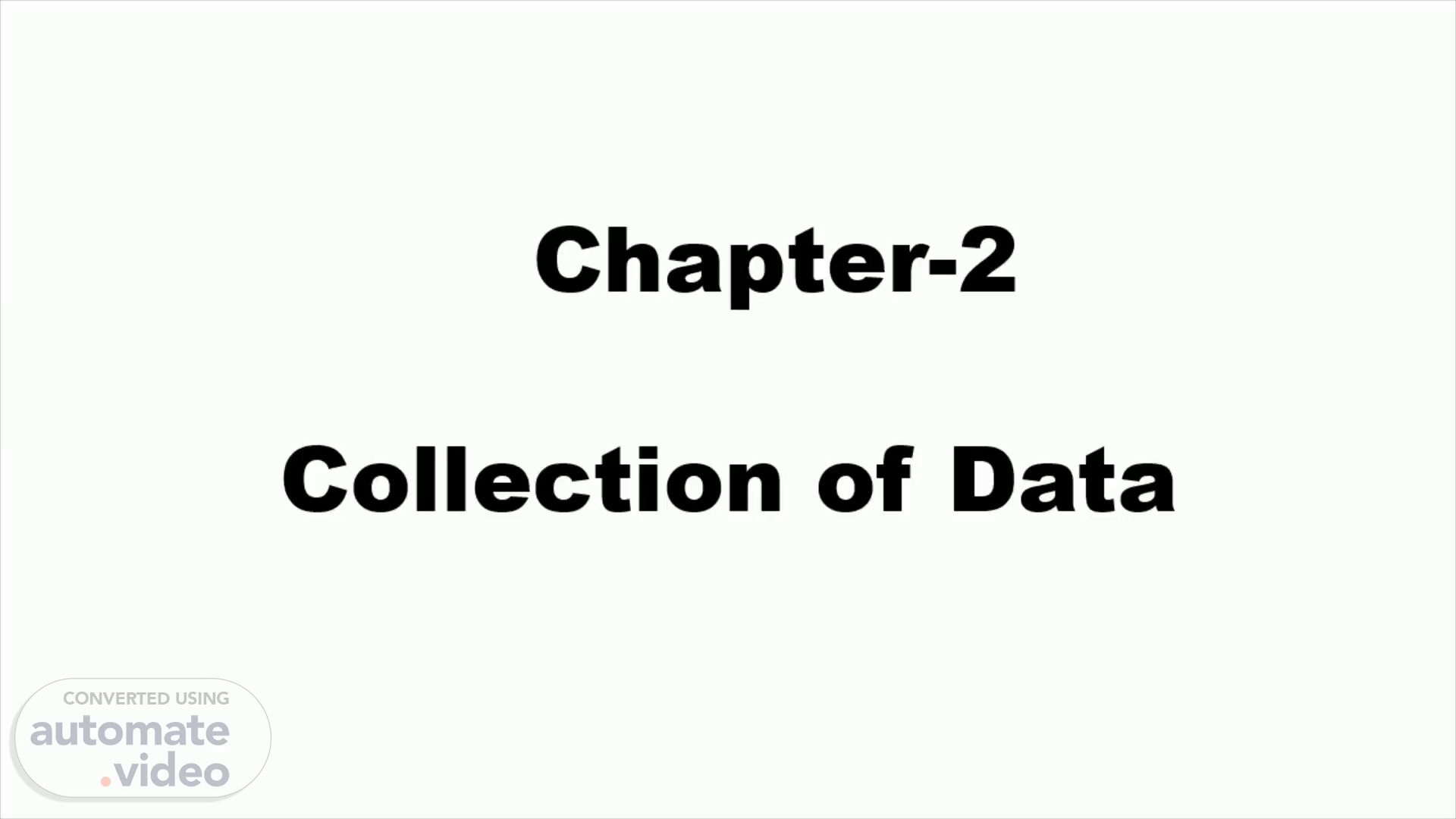Scene 1 (0s)
Chapter-2. Collection of Data.
Scene 2 (6s)
Introduction. In this chapter, we will study about:- Sources of Data Methods of collection of data. We will also study various types of data like :- Primary Data Secondary Data..
Scene 3 (19s)
Sources of Data. There are two sources of data: The researcher may collect the data himself by conducting an enquiry. Such data are called Primary Data. The researcher may use the data which has already been collected by some other agency. Such data are called Secondary Data..
Scene 4 (35s)
Collection of Data. The data may be collected by conducting surveys. The purpose of a survey is to collect data on characteristics like Price, Quality of a product etc. For this, the researcher needs to prepare questionnaire..
Scene 5 (49s)
Preparation of Instrument. The most common type of instrument used in surveys is questionnaire. While preparing the questionnaire or interview schedule, following points should be kept in mind: The questionnaire should not be too long. The questions should be easy to understand and there should not be any ambiguity. The series of questions should move from general questions to specific questions..
Scene 6 (1m 8s)
Mode of Data Collection. There are three basic ways of data collection: Personal Interview Mailing questionnaires Telephone interviews.
Scene 7 (1m 17s)
Personal Interviews. In this methods, the researcher personally contacts the respondents and asks the questions. He can explain questions and get spontaneous responses. Additional information can also be gathered. However, this method is costly in terms of time, effort and money..
Scene 8 (1m 32s)
Mailing Questionnaire. In this method, a questionnaire is sent to each individual by mail. This method is less expensive. A wider area including remote areas can be covered. This method also allows the respondents to take their time while responding to various questions. These days online surveys are very popular. However, this method has its own demerits. Respondents may not return the questionnaire or not answer all the questions. There is no body to clarify a question if the respondent fails to understand it..
Scene 9 (1m 56s)
Telephone Interviews. In telephone, questions are asks over the phone. This method is cheaper & can be conducted in a shorter time. The researcher may explain the questions to the respondents in case of need. It is particularly useful when the population is literate and spread over a large area..
Scene 10 (2m 12s)
Pilot Survey. Once the questionnaire is ready, it should be pre-tested with a smaller group of respondents. It helps the researcher in finding drawbacks of the questions. It also helps in assessing the clarity of instructions, and getting an idea of cost and time involved in the actual survey..
Scene 11 (2m 28s)
Census & Sample Surveys. Census A survey, which includes every element of the population, is known as Census or the method of complete Enumeration. Sample A sample refers to a subset of the population from which information is to be obtained. In this method, the investigator collects information from a representative sample. A good sample can provide reasonably accurate information at a lower cost & in shorter time. Most of the surveys are sample surveys..
Scene 12 (2m 49s)
Random Sampling In Random Sampling, individual units are selected from the population at random. Here, every individual unit has an equal chance of being selected in the sample. These units can be chosen by lottery method or through computer programmes. Non-Random Sampling In a non- random sampling method, all the units of the population do not have an equal chance of being selected & convenience or judgement of the investigator plays an important role in the selection of the sample..
Scene 13 (3m 12s)
Sampling & Non-Sampling Errors. Sampling Errors A population has two important characteristics- Central tendency (e.g. mean) & dispersion (e.g. standard deviation). The purpose of the sample is to get estimate of the population parameters. Sampling error is the difference between the sample estimate & the true value of corresponding population characteristic. We can estimate population characteristics by using information collected in the sample. The sample estimate may or may not match the value of the population characteristic..
Scene 14 (3m 34s)
Non-Sampling Errors Non-sampling errors include Sampling Bias, Non-response Errors & Errors in Data Acquisition (recording of incorrect responses which may be because of incorrect measurements or typing errors etc.) Non-sampling errors are more serious than sampling errors because a sampling error can be minimize non- sampling error, even by taking a large sample..
Scene 15 (3m 51s)
Census of India & NSSO. The census of India provides the most complete and continuous demographic record on various aspects such as the size of population, density, sex ratio, literacy, rural-urban distribution etc. The Census is being regularly conducted every ten years since 1881. The NSSO(National Sample Survey Office) was established by the Government of India to conduct nation-wide surveys on socio-economic issues. NSSO provides periodic estimates of literacy, school enrolment, utilization of educational services, employment etc..
Scene 16 (4m 15s)
Conclusion. Economic facts, expressed in terms of numbers, are called data. The purpose of data collection is to understand, explain, and analyse an economic problem. Primary data is collected by the researcher by conducting a survey. Secondary data is the data which has already been collected by others. The choice of source of data & mode of data collection depends on the objective of the study..
